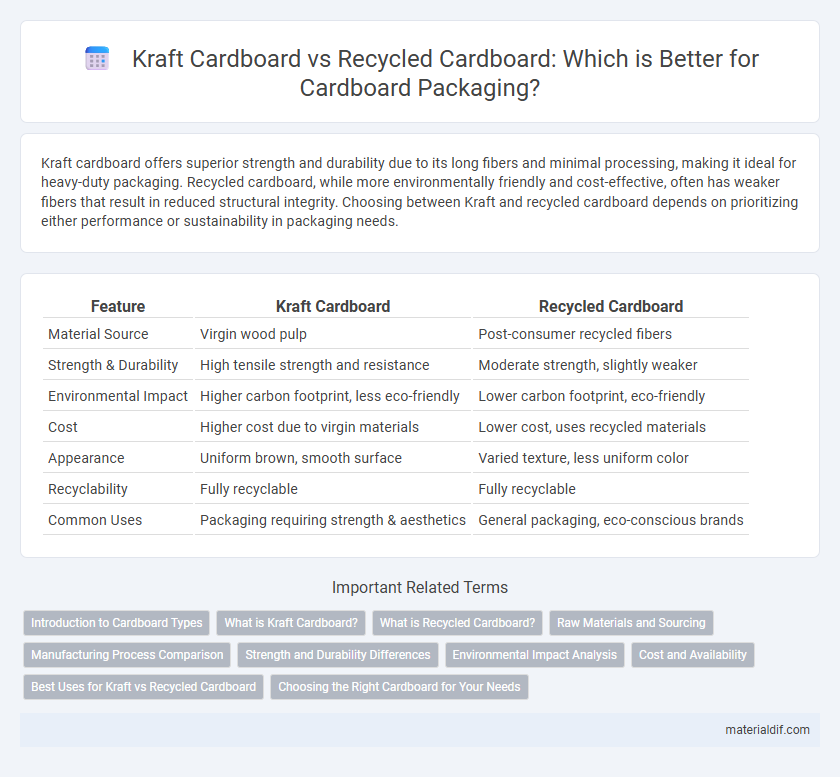Kraft cardboard offers superior strength and durability due to its long fibers and minimal processing, making it ideal for heavy-duty packaging. Recycled cardboard, while more environmentally friendly and cost-effective, often has weaker fibers that result in reduced structural integrity. Choosing between Kraft and recycled cardboard depends on prioritizing either performance or sustainability in packaging needs.
Table of Comparison
| Feature | Kraft Cardboard | Recycled Cardboard |
|---|---|---|
| Material Source | Virgin wood pulp | Post-consumer recycled fibers |
| Strength & Durability | High tensile strength and resistance | Moderate strength, slightly weaker |
| Environmental Impact | Higher carbon footprint, less eco-friendly | Lower carbon footprint, eco-friendly |
| Cost | Higher cost due to virgin materials | Lower cost, uses recycled materials |
| Appearance | Uniform brown, smooth surface | Varied texture, less uniform color |
| Recyclability | Fully recyclable | Fully recyclable |
| Common Uses | Packaging requiring strength & aesthetics | General packaging, eco-conscious brands |
Introduction to Cardboard Types
Kraft cardboard is produced from virgin wood fibers, offering superior strength, durability, and resistance to moisture, making it ideal for packaging heavy-duty products. Recycled cardboard is made from reclaimed paper fibers, promoting environmental sustainability by reducing waste and saving natural resources, though it typically has lower strength compared to kraft cardboard. Understanding these types helps businesses choose materials based on performance requirements and ecological impact.
What is Kraft Cardboard?
Kraft cardboard is a strong, durable material made from virgin wood fibers processed through the kraft pulping method, which preserves fiber length and enhances tear resistance. It typically appears natural brown and offers superior structural integrity compared to recycled cardboard, making it ideal for packaging that requires high strength. Unlike recycled cardboard, which incorporates mixed and weaker fibers, kraft cardboard maintains consistent quality and performance in industrial applications.
What is Recycled Cardboard?
Recycled cardboard is made from post-consumer and post-industrial waste, processed to create a sustainable, eco-friendly packaging material. It reduces the demand for virgin fibers, lowers environmental impact, and conserves natural resources compared to Kraft cardboard, which is produced from fresh wood pulp. The quality of recycled cardboard may vary depending on the percentage of recycled content and the manufacturing process, often resulting in a less durable but more environmentally responsible option.
Raw Materials and Sourcing
Kraft cardboard is manufactured using virgin wood fibers derived primarily from softwood trees, ensuring high-quality strength and durability due to its long fibers and chemical pulping process. Recycled cardboard utilizes previously used paper products as raw material, reducing the demand for virgin pulp but potentially compromising fiber length and structural integrity due to fiber degradation. Sourcing for Kraft cardboard often involves sustainable forestry practices certified by organizations like FSC, while recycled cardboard sourcing depends heavily on local recycling collection systems and post-consumer waste availability.
Manufacturing Process Comparison
Kraft cardboard is produced from virgin wood pulp using the kraft process, which involves chemical pulping for stronger, high-quality fibers and greater durability. Recycled cardboard is manufactured by repulping used paper products, combining fibers that are shorter and weaker, leading to reduced strength but increased environmental sustainability. The kraft process demands more energy and chemicals, whereas recycled cardboard manufacturing requires less resource intensity but often involves additional deinking and contaminant removal steps.
Strength and Durability Differences
Kraft cardboard is produced from virgin wood fibers, offering superior strength and durability compared to recycled cardboard, which contains a blend of used fibers that weaken its structural integrity. The long fibers in Kraft cardboard provide enhanced tear resistance and load-bearing capacity, making it ideal for heavy-duty packaging and shipping. Recycled cardboard, while environmentally friendly, tends to have a lower burst strength and is more prone to degradation when exposed to moisture or repeated use.
Environmental Impact Analysis
Kraft cardboard is made from virgin wood fibers, resulting in higher durability and strength but consuming more energy and water resources during production, which leads to a larger carbon footprint compared to recycled cardboard. Recycled cardboard utilizes post-consumer waste, significantly reducing deforestation, water usage, and greenhouse gas emissions, promoting a circular economy and minimizing landfill waste. However, the recycling process can slightly compromise material strength, necessitating specific applications where environmental benefits outweigh performance requirements.
Cost and Availability
Kraft cardboard is generally more expensive due to its higher quality and durability but offers consistent availability from virgin fiber sources. Recycled cardboard tends to be cheaper and widely accessible, though its supply can fluctuate depending on recycling rates and material quality. Businesses often balance cost savings with performance needs when choosing between these two cardboard types.
Best Uses for Kraft vs Recycled Cardboard
Kraft cardboard offers superior strength and durability, making it ideal for packaging heavy or fragile items, food containers, and retail displays requiring a premium appearance. Recycled cardboard is best suited for eco-friendly shipping boxes, bulk packaging, and temporary storage solutions where sustainability and cost-effectiveness are prioritized. Choosing between Kraft and recycled options depends on the balance between product protection needs and environmental impact goals.
Choosing the Right Cardboard for Your Needs
Kraft cardboard offers superior strength and durability due to its virgin fibers, making it ideal for heavy-duty packaging and shipping applications where protection is critical. Recycled cardboard provides an eco-friendly alternative with reduced environmental impact, suitable for everyday use and lightweight packaging needs. Choosing the right cardboard depends on balancing factors such as strength requirements, sustainability goals, and budget considerations to ensure optimal performance.
Kraft cardboard vs Recycled cardboard Infographic

 materialdif.com
materialdif.com